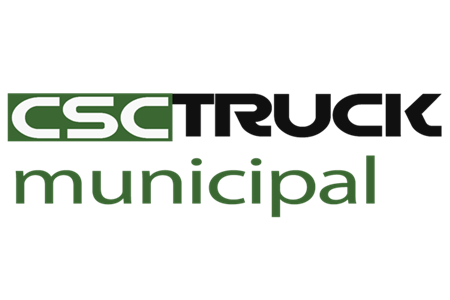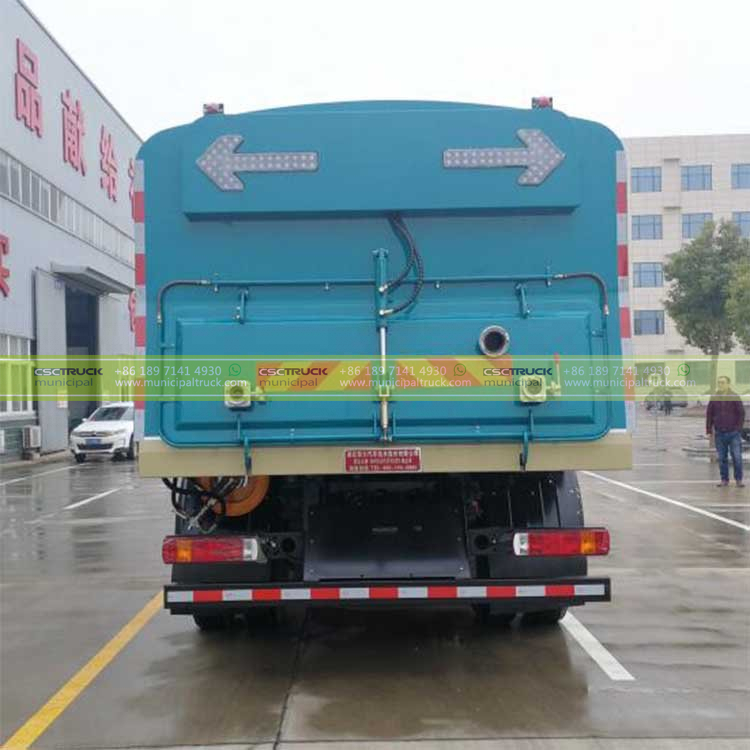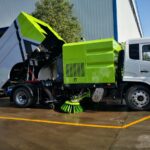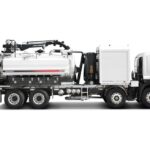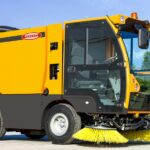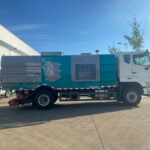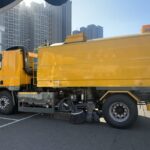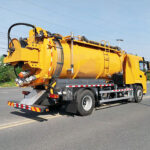The relentless demands placed upon municipal public works departments present a daily gauntlet of challenges, where the specter of unpredictable weather transforms routine maintenance into complex logistical puzzles, threatening operational efficiency, public safety, and environmental compliance with every seasonal shift and storm event. In this high-stakes environment, relying solely on single-function vehicles like traditional sweepers or dedicated jetters often translates to costly delays, redundant deployments, and critical gaps in service coverage when conditions turn adverse. The transformative solution lies in the engineering marvel of the Combined Sweeper Jetter Truck, a purpose-built powerhouse that seamlessly integrates the robust debris collection capabilities of advanced regenerative air or mechanical broom sweepers with the formidable hydro-flushing force of high-pressure jetting systems onto a single, highly mobile chassis. This fusion delivers unprecedented all-weather versatility, fundamentally redefining how cities combat grime, manage stormwater, and maintain infrastructure integrity year-round, irrespective of what nature delivers.
Confronting the Elements: Urban Weather Challenges Demand Adaptive Solutions
Municipal streets, parking structures, and drainage networks endure a brutal, unceasing assault from both natural forces and constant human activity, generating a dynamic spectrum of contaminants and hazardous conditions that fluctuate wildly with temperature, precipitation, and seasonal cycles, frequently overwhelming conventional, single-purpose equipment.
- Winter’s Icy Grip: Snow removal is merely the first act; the lingering residue of abrasive grit, corrosive road salt, and tenaciously bonded ice layers necessitates powerful mechanical scrubbing and thermal intervention. Standard sweepers falter against frozen debris, while standalone jetters struggle to effectively collect the heavy, sand-laden slush they dislodge, often leaving treacherous black ice or inadequately cleared drains prone to rapid refreezing.
- Spring Deluges & Thaw: Rapid snowmelt converging with seasonal downpours overwhelms storm drains with sediment scour, organic debris (sodden leaves, twigs), and mobilized litter, leading directly to localized flooding and potential breaches of water quality regulations if inlets and pipes aren’t proactively cleared and dislodged material swiftly removed from roadways before recirculation occurs.
- Summer’s Scorching Buildup: Prolonged dry spells allow fine dust, sand, and harmful airborne pollutants (PM2.5/PM10) to accumulate and cement onto pavement, degrading air quality and creating hardened surfaces resistant to dry sweeping, while simultaneously, spilled grease, motor oils, and chewing gum bake into stubborn, slick residues demanding thermal and chemical intervention for complete eradication.
- Autumn’s Leaf Onslaught: The sheer volume of wet, densely matted foliage creates significant traction hazards and poses imminent threats to stormwater systems; efficient mitigation requires not only powerful suction and containment for bulk removal but also immediate, high-pressure flushing capabilities to clear leaf-choked drains and gutters adjacent to the cleanup zone.
Synergistic Engineering: The Core Anatomy of a Combined Sweeper Jetter
The exceptional capability of a Combined Sweeper Jetter Truck stems from meticulous integration, not mere juxtaposition, where sophisticated subsystems are engineered to operate in concert, sharing resources and amplifying each other’s effectiveness for maximum impact from a single platform.
- High-Pressure Hydro-Jetting Heart: The core of the cleaning force, featuring a high-flow, industrial-grade positive displacement plunger pump (generating 1,500 – 3,500+ PSI / 100 – 240+ Bar), drawing from a substantial integrated clean water tank (1,500 – 3,000+ gal / 5,700 – 11,000+ L). Pressurized water is delivered via reinforced hoses to a rear-mounted, articulating hydro-jetting wand or strategically placed front/belly nozzles. Critically, onboard water heating systems (diesel-fired or heat-exchanger units achieving 180°F / 80°C+), exponentially boost efficacy against grease, oil, ice, and polymerized grime.
- Advanced Debris Management System: Comprising either a high-efficiency regenerative air system (utilizing a focused, high-velocity airstream ideal for fine dust and lighter materials) or a rugged mechanical broom assembly (heavy-duty bristles tackling compacted debris, often paired with air assist for recovery), feeding into a large-volume, abrasion-resistant debris hopper. The system’s genius lies in its integrated vacuum recovery, specifically designed to handle the challenging slurry of water and solids generated during concurrent jetting and sweeping operations.
- Robust Chassis & Power Integration: Built upon severe-duty truck chassis engineered for optimal weight distribution and durability, featuring robust Power Take-Off (PTO) configurations or dedicated auxiliary engines to drive the high-demand pump and sweeping systems without compromising mobility. Sophisticated hydraulic systems govern boom articulation, hopper dumping, broom pressure, and accessory functions, while multi-stage filtration protects sensitive jetting components and maintains water quality.
Subsection: Intelligent Control – The Operator’s Command Hub
Seamless, efficient operation is orchestrated through an intuitive, centralized control environment:
- Ergonomic Dual-Function Consoles: Modern cabs feature integrated touchscreens and multi-axis joysticks, allowing operators to effortlessly switch between or concurrently manage sweeping and jetting functions, controlling pressure, temperature, flow, broom parameters, suction power, and tool positioning from a single, comfortable station.
- Precision Performance Monitoring: Real-time feedback via flow meters, pressure sensors, and temperature gauges enables exact application control. Programmable settings allow operators to save and recall optimized configurations for specific, recurring tasks like “ice mitigation,” “gum removal,” or “post-event cleanup,” ensuring consistent, effective results.
Unleashing All-Weather Dominance: Practical Application Mastery
The true operational genius of the sweeper-jetter combination is realized in its ability to deploy the precisely calibrated tool – or powerful synergy of tools – instantaneously, transforming reactive scrambling into proactive, predictable response to any meteorological challenge.
- Vanquishing Winter Hazards: Utilize heated, high-pressure water jets to rapidly fracture and melt ice layers bonded to pavement (jetting function), while simultaneously deploying the mechanical broom to aggressively scrub the loosened material and the powerful vacuum to instantly recover the resulting slush, salt, and grit (sweeping function), preventing hazardous refreeze and restoring a clean, safe, dry surface exponentially faster than sequential deployments. Proactive hot water flushing of drains prevents ice dams before they form.
- Securing Stormwater Integrity: Deploy the hydro-jetting wand with pinpoint accuracy to clear blockages deep within catch basins and storm drain pipes (jetting function), while simultaneously using the sweeper’s superior recovery system to vacuum dislodged sediment, leaves, and litter directly from the surrounding street and gutter (sweeping function), preventing re-entry into the system or contribution to surface flooding. Pre-storm sweeps clear gutters proactively.
- Eradicating Stubborn Summer Contaminants: Apply heated, high-pressure water, potentially augmented by eco-friendly detergents via an integrated proportioning system, to dissolve and lift baked-on grease, oil stains, and gum (jetting function). The sweeper’s broom then scrubs the residue, and the vacuum ensures complete removal, eliminating residual slickness. For pervasive dust, employ the jetting system for targeted suppression spraying prior to sweeping.
- Conquering Autumn Leaf Fall: Utilize high-pressure water strategically to blast wet, matted leaves from gutters and curb lines (jetting function), rendering them accessible for the sweeper’s broom and high-capacity vacuum system to collect and contain large volumes efficiently in a single pass (sweeping function), while concurrently clearing adjacent drains.
Expanding Municipal Utility: Versatility Beyond the Street
The operational scope of the Combined Sweeper Jetter Truck extends far beyond conventional road cleaning, establishing it as an indispensable multi-role asset for diverse municipal infrastructure and public realm maintenance challenges.
- Parking Infrastructure Revitalization: Efficiently scour accumulated oils, grease, and debris from expansive municipal lot and garage surfaces; jetting cleans stains and expansion joints effectively, while sweeping ensures comprehensive recovery of loosened material.
- Public Event Space Restoration: Rapidly rehabilitate heavily soiled festival grounds, market squares, or park areas post-event; jetting tackles ground-in food grease, spills, and dirt around fixed infrastructure, while sweeping removes general litter and organic waste.
- Critical Bridge Deck Maintenance: High-pressure water jetting, potentially utilizing Ultra-High Pressure (UHP) configurations, effectively removes corrosive de-icing salts, rust scale, and failing coatings prior to repairs or sealing operations, while the integrated recovery system captures contaminated wastewater for compliant disposal, protecting waterways. Sweeping keeps critical expansion joints clear.
- Industrial Area & Spill Response: Provide rapid, contained cleanup for non-hazardous liquid spills (oils, coolants) or lightweight powder releases; use jetting (with detergents if needed) for dispersal coupled with immediate vacuum recovery by the sweeper to contain and remove the contaminant efficiently.
- Airport Operational Safety (FOD Control): Essential for Foreign Object Debris (FOD) mitigation on runways and aprons; specialized jetting clears resilient rubber deposits from landing zones while sweeping guarantees complete debris recovery. Hot water jetting excels at removing residual de-icing fluids.
Quantifying Advantage: Operational Efficiency & Fiscal Prudence
While the initial capital investment in a Combined Sweeper Jetter Truck commands attention, the compelling long-term operational economics and return on investment (ROI) provide a powerful justification for municipalities navigating constrained budgets and rising service expectations.
- Strategic Fleet Consolidation: One combination unit effectively eliminates the need for separate dedicated sweeper and jetter/vacuum trucks, significantly reducing the total fleet size, lowering aggregate acquisition costs, and freeing substantial capital for other critical municipal investments.
- Substantial Operational Cost Reduction: Consolidation delivers deep savings across the board: drastically reduced fuel consumption (single vehicle deployment), lower maintenance overhead (fewer engines, transmissions, chassis), decreased personnel costs (one operator per task), reduced facility requirements (parking, maintenance bays), and minimized insurance premiums.
- Enhanced Productivity & Responsiveness: Eliminating the coordination lag and travel duplication inherent in deploying multiple vehicles enables dramatically faster reaction times to urgent weather events, spills, or blockages. Complex, multi-faceted problems are addressed immediately upon arrival, often resolved in a single operational pass or significantly shortened timeframe.
- Maximized Annual Utilization: The inherent all-weather capability ensures productive operation in extreme cold, heat, wet, or dry conditions that would sideline standard sweepers or standalone jetters lacking integrated debris recovery, effectively extending the useful service season and maximizing asset utilization.
- Strengthened Regulatory Compliance: Effective, immediate removal of pollutants like oils, sediments, and de-icing chemicals significantly enhances a municipality’s ability to meet stringent Stormwater Pollution Prevention Plan (SWPPP) requirements and National Pollutant Discharge Elimination System (NPDES) permit obligations consistently, mitigating the risk of substantial environmental penalties.
Sustaining Peak Performance: Operator Excellence & Strategic Management
Harnessing the full potential of this sophisticated municipal asset necessitates a dedicated focus on human expertise and optimized operational protocols.
- Comprehensive, Ongoing Operator Training: Moving far beyond basic vehicle operation, effective training must encompass the nuanced interaction between jetting and sweeping functions, mastery of optimal pressure/temperature/flow settings for diverse contaminants and conditions, advanced techniques for efficient slurry recovery, stringent high-pressure water safety protocols, detailed preventative maintenance procedures, and adept troubleshooting skills for common system alerts. Scenario-based simulation training offers significant value.
- Data-Driven Operational Intelligence: Leverage GPS fleet tracking and advanced telematics to monitor real-time vehicle utilization, analyze route efficiency, pinpoint fuel consumption patterns, and identify excessive idle times. Systematically track job completion metrics, water usage, and fuel efficiency for different task types to continuously refine scheduling, identify training opportunities, and proactively flag potential maintenance needs before they cause downtime.
- Meticulous Preventive Maintenance Regimen: The high-stress nature of the pressure systems demands unwavering adherence to rigorous PM schedules. This includes meticulous servicing of pumps (seals, valves), frequent inspection and timely replacement of hoses and nozzles, strict adherence to filter change intervals, comprehensive hydraulic system checks, and regular assessment of sweeping component wear (broom bristles, skirts, conveyor systems). Detailed, digitized maintenance records are crucial.
- Proactive Critical Spares Management: Maintain a strategic on-hand inventory of high-failure-rate components (specialized nozzles, pump seals, unique hydraulic fittings, broom segments) to minimize operational downtime resulting from unavoidable wear or unexpected failures, ensuring rapid return to service, particularly crucial in anticipation of forecasted severe weather events.
The Horizon of Innovation: Emerging Technologies Shaping the Future
Continuous advancements promise to further elevate the efficiency, capability, and sustainability profile of Combined Sweeper Jetter Trucks, shaping the next generation of municipal cleaning.
- Intelligent Systems & Automation Integration: Enhanced IoT sensor networks providing real-time analytics on system health (pump performance, water temp, hopper load density, component wear) combined with AI-driven route optimization and GPS geofencing will enable predictive maintenance, minimize resource waste, and optimize daily workflows. Semi-autonomous boom and wand control systems are emerging.
- Advanced Water Sustainability: Development of compact, efficient onboard water recycling and filtration systems capable of treating recovered wastewater to a quality suitable for reuse in the jetting system (though typically not for potable use) will drastically reduce freshwater consumption, lower operational costs, and lessen environmental impact, especially critical in arid regions or under water restrictions. Rainwater harvesting integration may also emerge.
- Precision Application & Sensing: Automated debris detection systems (utilizing cameras, LiDAR, or other sensors) coupled with dynamic variable rate control for water pressure and flow, adjusting in real-time based on surface conditions, contamination levels, and vehicle speed, will optimize resource utilization (water, fuel, detergents) and cleaning efficacy, minimizing waste while maximizing results.
- Sustainable Powertrain Evolution: Accelerated exploration of battery-electric (BEV) and hybrid-electric powertrains for both the primary chassis and auxiliary systems, significantly reducing noise pollution, eliminating localized emissions during stationary operations (like extended jetting), and lowering the overall carbon footprint, aligning directly with ambitious municipal sustainability targets. Hydrogen fuel cell integration represents a longer-term frontier for extended range and zero-emission operation.
- Enhanced Debris Handling & Logistics: Innovations in hopper design focusing on faster, cleaner dumping cycles and potentially internal wash-down systems, more efficient dewatering mechanisms for sludge handling, and exploration of onboard compaction for certain waste streams will increase operational uptime and payload efficiency, reducing trips to disposal sites.
The Combined Sweeper Jetter Truck stands as a pinnacle of applied engineering, strategically designed to conquer the multifaceted, weather-driven challenges that define modern municipal operations, offering an unmatched level of operational flexibility that renders traditional equipment limitations obsolete and fundamentally transforms urban cleanliness, safety, and environmental stewardship across all seasons. While the dedicated road sweeper truck remains perfectly suited for efficient dry debris collection during favorable conditions, and the sprinkler truck fulfills specific dust suppression or pre-wetting roles, the unparalleled integrated capability and profound all-weather versatility of the combined sweeper jetter unequivocally establish it as the indispensable, dominant force for tackling the most severe, variable, and meteorologically complex cleaning and maintenance tasks faced by progressive public works departments, ensuring communities remain resilient, functional, and visually appealing regardless of the unpredictable elements.
